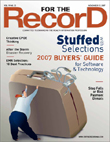November 12, 2007
 Share and Share Alike
Share and Share Alike
By Lee DeOrio
For The Record
Vol. 19 No. 23 P. 10
If the annual AHIMA conference is about anything, it’s about exchanging information. Whether it be from colleague to colleague, expert to student, vendor to potential customer, or industry leader to enraptured neophyte, there are all sorts of wisdom being bestowed.
This year’s get-together in Philadelphia was no different. Overflow crowds greeted many presenters who updated and informed attendees on the latest goings-on in coding, transcription, electronic health records (EHRs), and research.
One of the highlights was the presentation given by Robert Kolodner, MD, the head of the Office of the National Coordinator for Health Information Technology. Kolodner discussed HIT’s future and how it can move the healthcare industry from one that treats to one that prevents and, eventually, predicts disease. Toward that end, he suggested employing genetic information as a tool and linking it to EHRs.
But that’s down the road. Currently, much of the information needed to improve healthcare quality is trapped in silos, according to Kolodner. “It can’t move or communicate,” he said. “It needs to move to broader support of healthcare and move to practices, home, and the workplace.”
Kolodner cited the following five pieces needed to reach the “HIT tipping point”:
• standards in HIT products;
• privacy and security policies;
• a national health information network;
• adoption of interoperable HIT; and
• governance.
Together, these ingredients could enable a transparent system that can deliver EHRs, personal health records (PHRs), and public health information.
In regard to PHRs, the AHIMA announced that it is taking a leading role in this movement by establishing a public awareness campaign to urge consumers to assume responsibility of their health information. Dubbed “It’s HI Time, America!”, the program calls on HIM professionals to educate and encourage healthcare consumers to begin their own PHR.
“This campaign is all about patient-centric healthcare in America and the need for many of us to really get ahead of the curve in learning to access and use our personal health information,” said AHIMA CEO Linda L. Kloss, MA, RHIA, CAE.
Those interested in exploring the nuances of PHRs can visit www.myphr.com to learn how to create an effective PHR, including the steps needed to obtain medical records.
Other notable speakers at the conference included Carolyn Clancy, MD, director of the Agency for Healthcare Research and Quality, who deadpanned, “I’m from the government, and I’m here to help.”
Clancy said paper charts are not sustainable for the future as she presented statistics that showed healthcare costs increasing 8% on average per year, while healthcare quality was improving only 3% annually.
HIT can help correct that disparity, but Clancy cautioned that it’s not simply a matter of implementation. “Health IT can ease the financial strain, but steps need to be taken to address data content standards,” she said.
— Lee DeOrio is the editor of For The Record.



